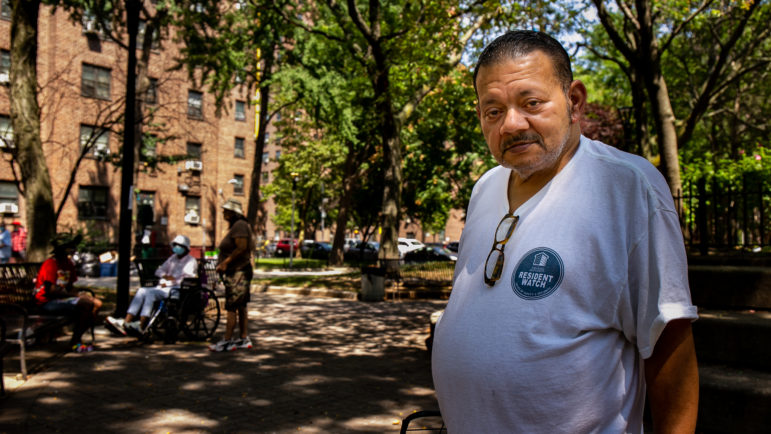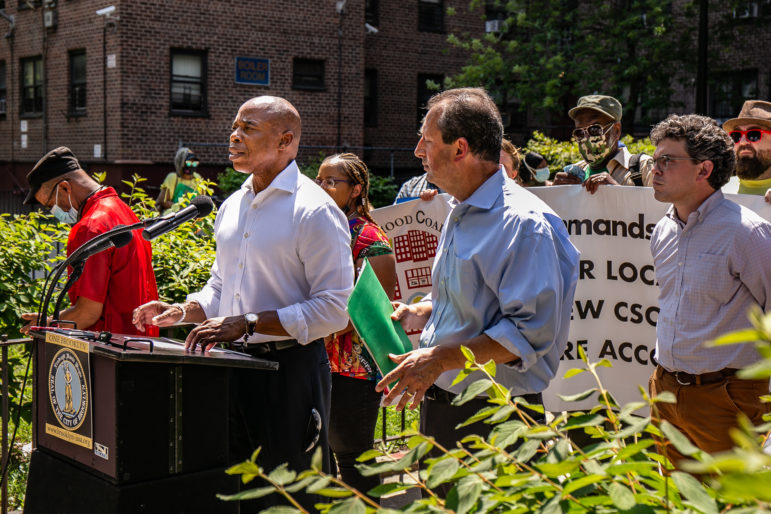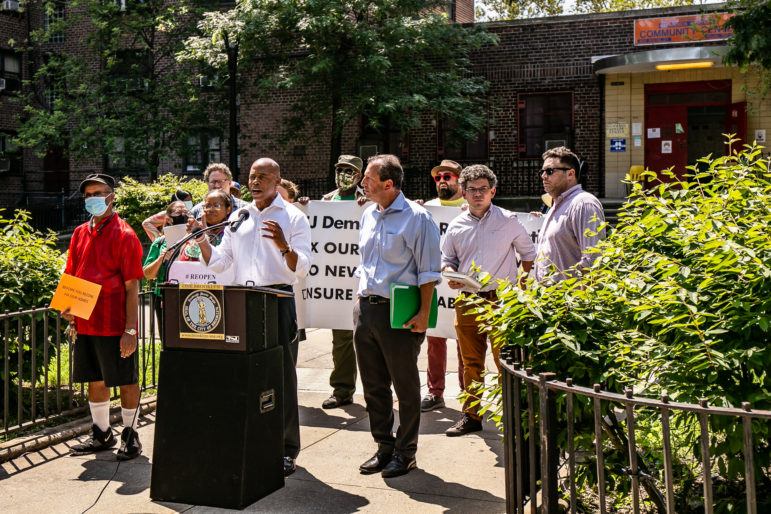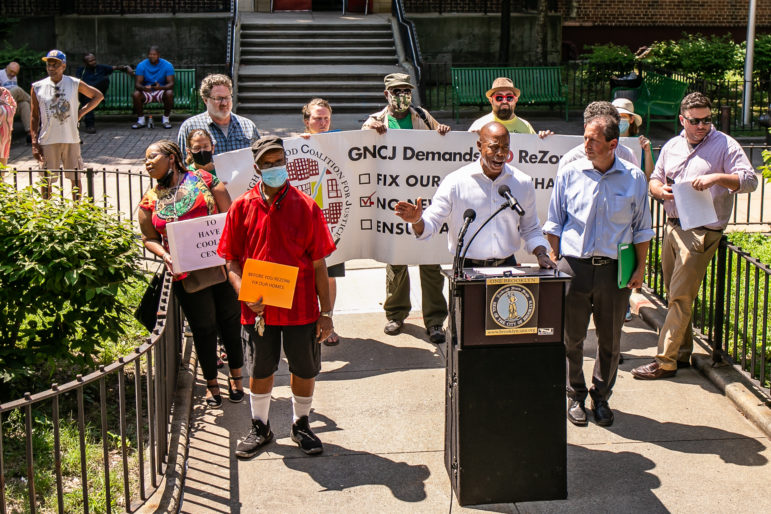“Buildings cannot go up around NYCHA developments while residents see their futures go down,” Adams said outside the Gowanus Houses Friday.
New York City’s likely next mayor is signing off on the Gowanus upzoning proposal backed by the current one—so long as the final plan includes a strategy for funding local NYCHA renovations.
Brooklyn Borough President Eric Adams, the Democratic nominee for mayor, said he will recommend approval of a land use application to rezone 82 blocks of the Brooklyn neighborhood for higher density development if the city “commits upfront to the capital needs” at the Gowanus Houses and Wyckoff Gardens, two public housing complexes located within the proposed rezoning area. The repairs are estimated to cost $274 million.
If the city does not fund those capital needs, Adams said he would recommend capping the heights of new buildings and forcing developers to purchase air rights on NYCHA property, allowing the public housing agency to use the proceeds to fund repairs.
“New York City is always changing, but every once in a while we need a sea change,” Adams said outside the Gowanus Houses Friday. “Buildings cannot go up around NYCHA developments while residents see their futures go down.”
“NYCHA needs to be part of the prosperity of this city and this borough,” he continued. “We are going to put public housing residents front and center.”
The land use plan proposed by Mayor Bill de Blasio would allow for larger residential buildings along the Gowanus canal and a 900-unit affordable housing complex on the former industrial site known as Public Place. The plan would further environmental remediation efforts in the polluted canal and surrounding land.
Brooklyn’s Community Board 6 voted last month to back the proposal, but only if the city funds the NYCHA repairs. Under city land use rules, the borough president makes an advisory recommendation on rezoning applications following the community board decision.
Adams described the NYCHA capital funding demand as “a model” for future upzonings, telling reporters that land use applications must also address public housing needs, though he stopped short of saying it should be a condition of every future rezoning.
“When you look at rezoning around NYCHA locales, we are going to look into the model that, attached to the rezoning, is also going to affect NYCHA,” he said. “Air rights around NYCHA is part of the ecosystem around NYCHA.”
He also cited the results of the 2020 U.S. Census, which showed that Brooklyn’s overall population increased even as the number of Black and African American residents dropped by more than 8 percent. In Gowanus, a predominantly white neighborhood, most Black residents live in public housing campuses. A racial impact study conducted by Columbia University researchers found that the proposed rezoning would increase diversity in the neighborhood. Future rezoning applications will also now undergo mandatory racial impact studies, based on a bill recently passed by the City Council.
In all, Adams outlined 38 recommendations for the rezoning plan in a 13-page printout distributed to press and local residents. The guidance includes ensuring permanent affordability for all below-market-rate units, extending community preference to former residents of Community District 6 forced to move by rising rents, and fully funding renovations at the Pacific Street Library and local parks.
Some residents of the Gowanus Houses sat on park benches or chatted in a nearby courtyard while advance teams for Lander and Adams set up a podium and prepared for the press conference. They described the need for renovations across a campus where elevators routinely break down, gas goes out for months and paint peels from apartment walls.
Margaret Sellars, 87, said she has lived in the development for 53 years and has seen conditions worsen. “When I moved here, there were more workers,” Sellars said. “They kept the place clean and the elevators working.”
Sellars uses a wheelchair and said she is sometimes stuck in her seventh-floor apartment when the elevators break down, as they did last week. “When the elevators aren’t working, I don’t come down,” she said.

Adi Talwar
Jose Guerrido said he would support the rezoning if it does included funding for needed NYCHA renovations.Resident Watch volunteer Jose Guerrido, 61, said he has heard conflicting and confusing information about the rezoning from his neighbors, including some who have said that NYCHA tenants will have to move out of their homes. That would not be the case under this plan.
Guerrido said he would support the rezoning if it does indeed include the needed renovations—like better paint, plumbing repairs and reliable elevators—as well as remediation at the toxic Gowanus canal.
“We need to get the money for the upgrades,” he said. “They fixed the front door. Now they have to fix the back door. The boiler needs to be repaired. The grass needs to be greener. The elevators need to work.”
The Gowanus proposal would change zoning rules in the low-slung neighborhood for the first time in more than 50 years. The city’s plan entered the public review process in May, amid intense opposition from many local residents.
Those opponents, including some who attended Friday’s press conference, said residential towers up to 30-stories tall will forever alter the character of the community while giving away too much to private developers, with too little affordable housing in return.
“Community board members are being asked to make a huge decision to transform Gowanus in a way that will make it unrecognizable in a few years,” said Debbie Stoller, a member of group Voice of Gowanus during a June community board hearing. “Hudson Yards is 28 acres. The Gowanus rezone encompasses 110 acres … We will end up as one of the neighborhoods that’s the tallest and densest in the borough.”
But others, including local Councilmember Brad Lander, say they support the plan so long as it includes funding for the needed repairs at the Gowanus and Wyckoff Gardens Houses. “It needs to be done with residents to establish the priority list for how that money is spent,” Lander said Friday.
Lander, the Democratic nominee for city comptroller, also acknowledged the opposition to the land use plan from many long-time residents.

Adi Talwar
Eric Adams and Brad Lander at a press event in front of the Gowanus Houses Community Center regarding rezoning.“It’s no secret that New Yorkers are skeptical of rezonings and often with good reason,” he said. “Too often the rezonings of the past have displaced low-income and working-class tenants because they’ve been in neighborhoods that were largely low-income communities of color, so the new market rate housing was out of the character of the neighborhoods but also had displacement impacts, and didn’t even create affordable housing at prices that were affordable for neighborhoods in the area.”
Unlike those rezonings, he said the affordable housing included in the Gowanus plan would likely attract lower- and middle-income New Yorkers from outside the neighborhood.
His remarks echoed statements made by Association for Neighborhood & Housing Development Land Use Policy Coordinator Chris Walters at the June community board hearing on the proposal. Walter said the Gowanus plan differs from past neighborhood-level rezonings pursued by de Blasio because it hones in on a wealthier, predominantly white area. Previous rezoning proposals transformed predominantly low- and middle-income communities, like East New York or the blocks around Jerome Avenue in the Bronx.
“This is the first of those rezonings we feel can advance racial equity in our city, but only if it is done right,” Walters said, adding that the proposal would create “more affordable housing in a higher ratio than is being produced today in a whiter and wealthier community district, bringing affordable housing to a wider range of households.”














2 thoughts on “Eric Adams Backs Gowanus Rezoning Plan, With NYCHA Funding Conditions”
Any plan that trades the health and welfare of low income BIPOC people for housing on the most toxic site in NYC is flawed.
The Gowanus Rezoning is a overreaching
Plan that has 133 toxic sites in an 80 block FEMA Flood zone
Bad plan for residents and tax payer giveaway yo real estate developers.
Adam’s raised $7 million from the real estate developers because they know he’ll support their profits by supporting the rezoning
Say no the the Gowanus Rezoning
Doesn’t look like either of these men are showing the leadership courage New York needs to address climate impacts and the city’s contribution to those raising impacts.